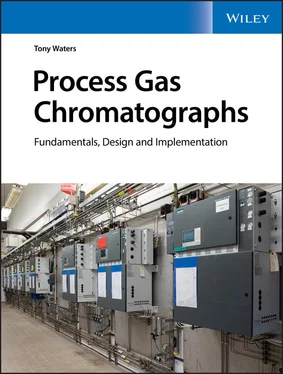In chromatography theory, the plate number( N ) is the number of equilibria achieved by a column. Of course, the notion of separate equilibria occurring in the column is just a theoretical concept. One might argue that the gas and liquid never quite achieve equilibrium because the gas is constantly moving. True; and that leads to another theory of chromatography, which assumes equilibrium never happens. Nevertheless, even that theory ends up with a plate number to express the efficiency of a column, its ability to produce narrow peaks.
The plate number is a useful parameter for evaluating column performance. As is evident from Figure 2.9, anything that increases the plate number must be a good thing, because it reduces peak width and narrower peaks provide better separations.
Figure 2.9contains a lot of information. Let's pause for a moment and see what it can tell us.
Identical molecules – different behavior
Notice that the propane molecules do not all spend the same time in the column, even though they are identical to each other. They enter the detector at different times.
The variable arrival time of identical molecules at the detector is the root cause of chromatogram peak shape .
Clearly, some of the propane molecules are delayed longer in the liquid phase than others are. It's a crap shoot in there, a totally random process where some get left behind and others don't. As a result, the peak shape follows the standard bell‐shaped curve that is found in many random processes. You saw this happen in Figures 2.5– 2.8.
All peaks are symmetrical
The statistical bell‐shaped curve is named for Carl Friedrich Gauss, the acclaimed German mathematician who derived its mathematical equation. The two major theories of chromatography both deduce that all the peaks in the column should be Gaussianin shape.
Thus, our ideal peaks in Figure 2.9are perfectly symmetrical. Unfortunately, real peaks are not perfect, and they may be slightly or grossly asymmetric due to other mechanisms occurring in the columns or in the instrument itself.
More equilibria – narrower peaks
On a given column, the peaks always get narrower as the number of equilibria increases. This is a very important observation because narrow peaks are highly desirable. It's so much easier to separate narrow peaks from each other than to separate wide peaks from each other. Therefore, to ensure that the peak widths are as narrow as possible, we adjust the column operating conditions − particularly the carrier gas flow rate − to generate the maximum number of equilibria.
In practice, each peak exhibits a different plate number. We can calculate the plate number of a selected peak from chromatogram measurements of its width and retention time. This calculation is used to evaluate column performance and to optimize column operating conditions. We'll look at it later.
It follows that a certain length of column must be necessary to generate each equilibrium. You can calculate it if you wish: just divide the column length by the plate number. In most columns the answer will be about 0.5 mm. We call this the plate height( H ). It's a very important parameter for optimizing the performance of a column.
More equilibria – taller peaks
The apex of the peak gets higher when the plate number increases. It actually gets very much higher because the peak area remains constant (the vertical axis in Figure 2.9is not drawn to scale). A higher peak in the graph means there are more molecules in the detector and a larger detector output signal, making the peak easier to measure. The chromatogram baseline always suffers from a little detector signal noise, so a higher peak has a better signal‐to‐noise ratio.
The apex of the peak is where the most propane molecules are. It's the highest concentration of propane molecules in the carrier gas. With symmetrical peaks like these, it's also the position of the average molecule. Since the recorded peak retention time should represent an average molecule, the elapsed time at peak apex is our best estimate of its retention time.
More equilibria – same retention time
In Figure 2.9, the retention time of the propane peak is always the same, regardless of the plate number. The plate number of a column affects only the peak width; it has no effect on the peak retention time.
In Figure 2.9, the peak apex has traveled along the column exactly half the distance that the carrier gas has traveled. This remains true during all of its journey through the column. When the carrier gas reaches the end of the column, as depicted, the propane peak has reached the mid‐point. At that time, it's only halfway through the column.
That's a lot of information to absorb, and it's all important for understanding how columns separate components. Before we look into what causes separation, you might want to read it again .
The SCI‐FILE that follows is optional reading, but is not difficult to understand. It gives a more technical account of solubility, so you may find it interesting.
SCI-FILE: On Solubility
Solubility
The main text uses the concept of “solubility” because it's intuitive and easy to understand. The solubility of a component depends on how easily its molecules can interact with the molecules of the stationary phase.
In that text, we make the simplifying assumption that “75 % solubility” means 75 % of the molecules dissolve in the liquid phase and 25 % remain in the gas phase.
While convenient and applicable to a given column, this representation fails to account for the volume of each phase inside the column, an important variable. Instead of using the number of molecules, the formal expressions of solubility use the concentration of the solute in each phase, thus incorporating the volume of each phase.
In the gas chromatography literature, the process and outcome of equilibrium is often called partition. The partition coefficient is the ratio of solute concentrations in each phase.
Chemists now prefer to reserve partition for liquid‐liquid systems. For gas‐liquid systems, the equivalent term is distribution, and the ratio of the solute concentrations in the gas and liquid phases is called the distribution constant.
The distribution of molecules between gas and liquid phases in a chromatograph column is a special case of Henry's Law: the concentration of a gas dissolved in a liquid is directly proportional to the partial pressure of that gas in contact with that liquid.
The distribution constant ( K c) is defined for a specified solute A as the equilibrium concentration of A in the stationary phase divided by the equilibrium concentration of A in the mobile phase:
SCI‐FILE: (2.1) 
Where the square brackets are a standard chemical shorthand for [ the concentration of ].
The theory assumes that the distribution constant will remain constant . It is assumed, for example, that the distribution of propane molecules at equilibrium is constant regardless of the number of propane molecules present, and that the distribution is unaffected by the presence of other solute molecules in the stationary phase.
Читать дальше













